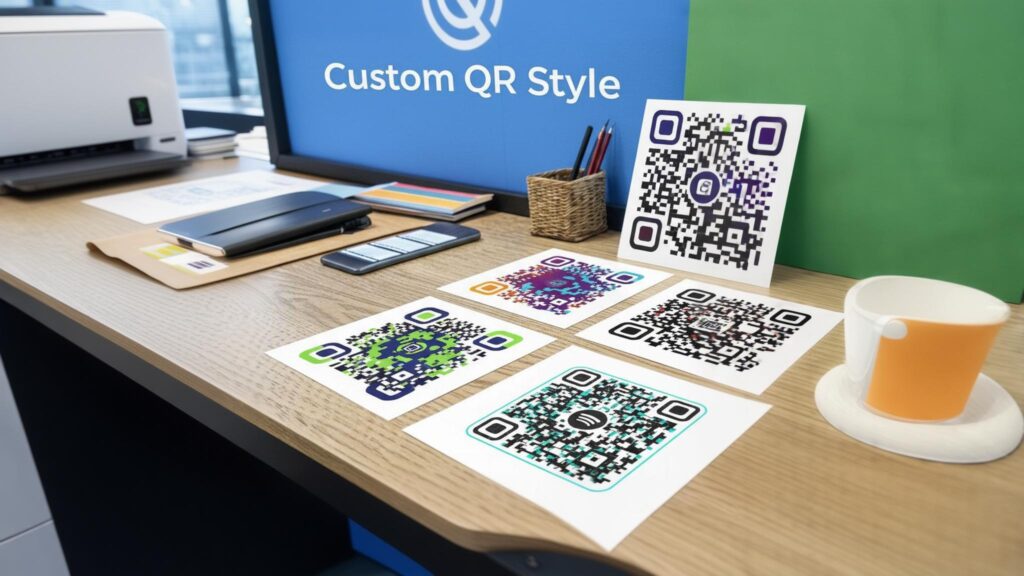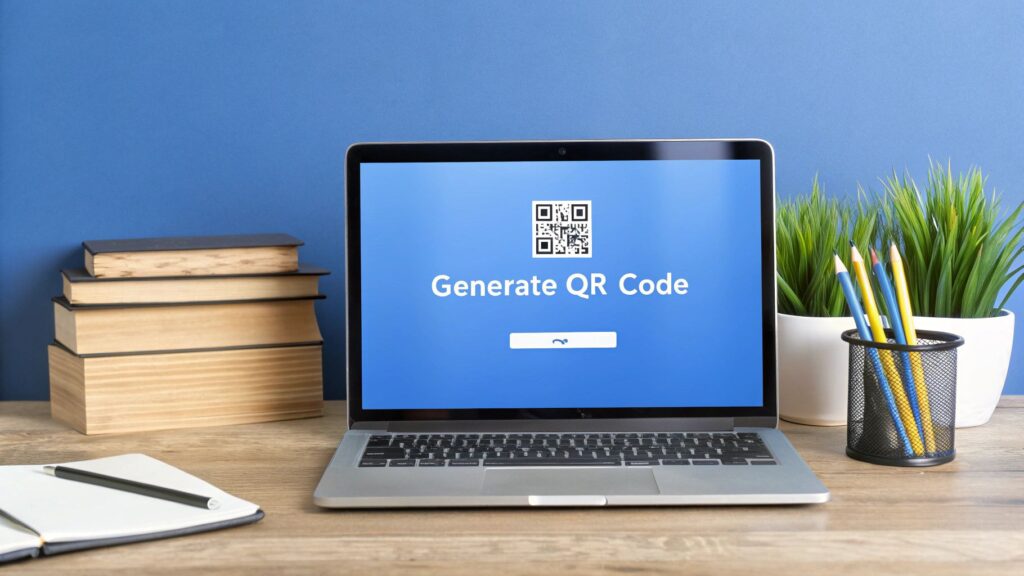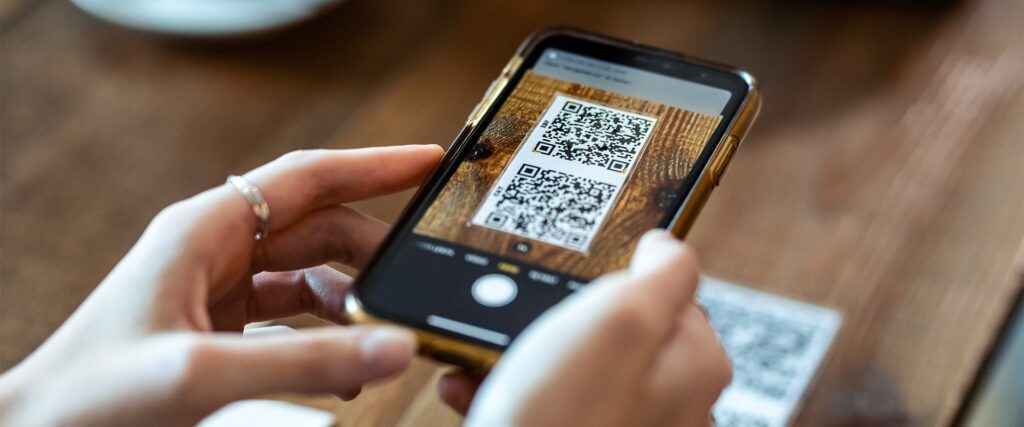A PDF QR code combines the convenience of QR codes with the power of PDF documents. These two-dimensional barcodes allow you to link directly to a specific PDF file using a simple scan. Unlike traditional QR codes that typically lead to websites or other online content, PDF QR codes provide a seamless way to share and access PDF files in both physical and digital contexts.
How Do They Work?
- Encoding PDF Information: When you create a PDF QR code, it encodes the URL or direct link to a PDF document. This link can point to a file stored on a server, a cloud storage platform, or any accessible location.
- Scanning and Decoding: Users can scan the QR code using their smartphones or other QR code readers. The scanning app decodes the embedded link and opens the associated PDF file.
- Benefits:
- Efficiency: Instead of typing long URLs or searching for specific documents, users can quickly access PDFs by scanning the code.
- Versatility: PDF QR codes work offline, making them ideal for conferences, printed materials, and physical displays.
- Shareability: Share brochures, product manuals, event schedules, or research papers seamlessly.
Use Cases and Applications of PDF QR Codes

It’s one thing to know how to make a PDF QR code, but seeing where they’re making a real impact can spark some great ideas. Most people think of restaurant menus, and that’s a fair start, but their true power lies in their versatility across countless industries. These simple squares are quietly solving problems and making information instantly accessible in some really clever ways.
Let’s look past the dinner table. Picture a real estate agent’s “For Sale” sign. Instead of a flimsy flyer box that’s always empty, there’s a sleek QR code. A passerby scans it and immediately gets a full-color, multi-page brochure on their phone – complete with stunning photos, floor plans, and all the property details. It’s a better experience for the buyer and a smarter system for the agent.
Business Scenarios
- Product Brochures and Catalogs:
- Companies can create QR codes for product brochures, catalogs, or user manuals. Placing these QR codes on packaging or marketing materials allows customers to scan and instantly access detailed information about the product.
- For instance, a QR code on a cereal box could lead to a digital brochure with nutritional facts, recipes, and serving suggestions.
- Event Schedules and Materials:
- Event organizers use QR codes to share schedules, speaker bios, and session details with attendees. Participants can scan the codes to access conference agendas, workshop materials, or event maps.
- QR codes on event badges can link to personalized schedules or virtual networking profiles.
- Educational Resources:
- Schools, universities, and training programs distribute QR codes to students. These codes provide access to lecture notes, study guides, or supplementary materials. For example: A professor puts a QR code on the final slide of their lecture. Students scan it as they leave and get the complete lecture notes, supplemental readings, and links for further research. It’s far more efficient than typing a long, complicated URL from the screen.
- Teachers can create QR codes for homework assignments, linking to relevant PDFs or online resources.
- Smart Product Packaging:
- Brands can enhance product packaging by embedding QR codes. Scanning these codes reveals assembly instructions, warranty details, or troubleshooting guides.
- Imagine buying a new gadget and instantly accessing its user manual via a QR code on the packaging.
Internal Operations and Training
- Access internal resources
Employees can scan a QR code to access company policies, training materials, or internal knowledge bases. - Machine maintenance logs
Attach QR codes to equipment for easy access to maintenance logs, safety instructions, or troubleshooting guides. - Streamline onboarding process
New hires can scan a QR code to access onboarding materials, benefits information, or company directories. - Manufacturing and Assembly:
Simple example: technician on a factory floor needs the specs for a complex piece of machinery. Instead of hunting for a binder, they scan a small, durable QR code right on the equipment. Instantly, the complete technical manual or assembly guide pops up on their tablet. No more wasted time or costly mistakes.
Personal Use:
- QR Codes in Resumes and Portfolios:
- Job seekers can stand out by embedding QR codes in their resumes or portfolios. These codes link to online portfolios, where potential employers can view work samples, projects, or certifications.
- A designer might include a QR code on their resume, directing recruiters to their online design portfolio.
- Sharing Project Reports and Research Papers:
- Researchers, students, and professionals can use QR codes to share project reports, research papers, or case studies. Colleagues or clients can scan the code to access the full document.
- This eliminates the need to email large attachments or print physical copies.
- Artistic and Creative Applications:
- Artists, photographers, and writers can leverage QR codes to link to their creative works. For example, a photographer might place QR codes next to exhibited photos, allowing viewers to explore behind-the-scenes stories or purchase prints.
- Writers can use QR codes in printed books to provide additional content, such as author interviews or multimedia elements.
- Personal Archives and Family History:
- Individuals can create QR codes for personal archives, family recipes, travel journals, or genealogical records. Scanning the code reveals the associated PDF document.
- Imagine preserving family recipes by linking them to QR codes in a family cookbook.
How to Create a QR Code for Your PDF: A Step-by-Step Guide

- Choose a PDF QR Code Generator:
- Start by selecting a reliable PDF QR code generator that supports PDF QR codes. For example OpenQr QR code. OpenQR platform allows you to create customized QR codes with specific functionalities.
- Upload Your PDF:
- Choose PDF QR code type from the list. Most QR code generators and also OpenQR provide an option to upload your PDF directly.
- Customize the QR Code:
- Design: Customize the appearance of your QR code. You can choose colors, add a logo (if desired), and adjust the code’s visual elements.
- Branding: Consider adding a relevant icon to the center of the QR code. This reinforces your brand identity.
- Custom domain: Add a custom domain to your QR code. This also increase the trust of your QR Code.
- Generate the QR Code:
- Click the “Save” button to create your PDF QR code.
- The platform will generate you a downloadable QR code image.
- Test Scannability:
- Print the QR code and test it using various QR code scanning apps on different devices (iOS, Android).
- Ensure that the code scans correctly and leads to the intended PDF.
PDF QR codes seamlessly blend the physical and digital worlds, offering a convenient way to share information. Whether you’re a restaurant owner enhancing your menu experience or an individual sharing project reports, QR codes provide efficiency, accessibility, and versatility.
Guide Users with a Clear Call to Action
You can’t assume everyone knows what your QR code does. A simple, direct instruction removes all the guesswork and can massively boost how many people scan it. A short phrase tells them exactly what to expect.
Here are a few real-world examples:
- For a restaurant menu: “Scan for Our Full Menu”
- For a product manual: “Download the Setup Guide”
- For an event schedule: “View the Conference Program”
This tiny bit of text transforms a mysterious pattern into a helpful shortcut. This is especially true in retail, where 62% of retailers using QR codes have reported a direct lift in sales. Clear, actionable instructions get results. You can discover more insights about retail QR code marketing.
A well-designed QR code does more than just link to a PDF; it acts as a visual signpost, guiding your audience to the information they need with confidence and ease.
By keeping your design clean and always exporting a high-resolution image, you ensure a smooth user experience. For a deeper dive, check out these general QR code best practices that apply to any project. These tips will help you create a PDF QR code that’s not just scannable, but genuinely effective.
Common Questions About PDF QR Codes
When you start working with QR codes for your PDFs, you’ll probably run into the same questions I did at first. Getting these sorted out from the get-go can save you a ton of headaches down the road.
Let’s walk through some of the most common things people ask. A little bit of clarity here will make sure your QR codes do exactly what you need them to do.
Can I Change the PDF After My QR Code is Printed?
This is probably the most important question of all, and the answer is a big “it depends.” Yes, you can change the PDF, but only if you created a dynamic QR code. Think of a dynamic code as a smart pointer. It doesn’t lead directly to your file; it leads to a special, short link that you control. You can log in anytime and redirect that link to a new PDF without ever touching the printed QR code.
On the other hand, if you made a static QR code, you’re out of luck. The link to your PDF is permanently burned into the code’s pattern. If you need to update that PDF, you have to generate and print a whole new QR code. For almost any serious use, dynamic is the way to go.
Do PDF QR Codes Expire?
Again, this comes down to whether your code is static or dynamic.
- Static QR codes never expire. The data is right there in the code itself. As long as the URL it points to is still live, the code will work forever. It’s completely self-sufficient.
- Dynamic QR codes rely on a service provider. This means they could stop working if your subscription or trial with the PDF QR code generator platform (like OpenQr) ends. Just make sure your account is active, and your codes will stay live.
What is the Best File Format for My QR Code?
Picking the right file format is all about where your QR code will live. It’s a simple choice, but getting it wrong can make your code unscannable.
For anything digital—your website, an email signature, a social media post – a PNG file is perfect. It’s high-quality, has a transparent background option, and works everywhere online.
But for print? You absolutely need an SVG (Scalable Vector Graphic). Whether it’s on a tiny business card or a massive trade show banner, an SVG can be resized to any dimension without getting blurry or pixelated.
I can’t tell you how many times I’ve seen a fuzzy, unscannable QR code on a poster. It’s almost always because someone used a low-resolution PNG instead of an SVG. Always, always use SVG for print.
How Do I Track Scans on My QR Code?
If you want to know how many people are scanning your code, you’ll need a dynamic QR code. This is where they really shine. Platforms that offer dynamic codes almost always include an analytics dashboard.
From there, you can see all sorts of useful information in real-time. You’ll typically find out how many total scans you’ve received, the city and country where people are scanning from, and even the time of day they’re most active. This kind of data is gold for figuring out if your marketing materials are actually working.
